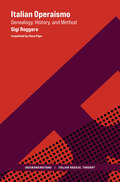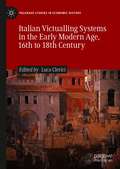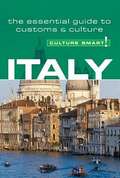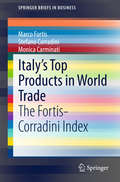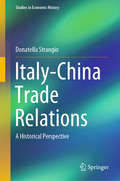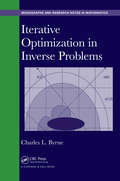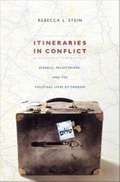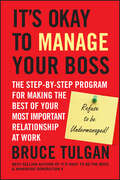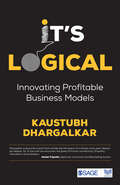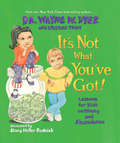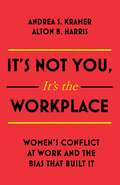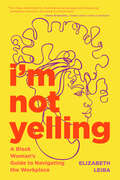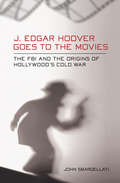- Table View
- List View
Italian Operaismo: Genealogy, History, Method (Insubordinations: Italian Radical Thought)
by Gigi RoggeroAn accessible, introductory presentation of operaismo, one of the most important revolutionary theories and praxes of the twentieth century.&“Operaismo is a Machiavellian return to first principles: it is a return to Marx against Marxism, against its tradition of determinism, historicism, and objectivism. Operaismo isn&’t a heresy within the Marxist family, it is a rupture with that family.&”—extract from Italian Operaismo This accessible, introductory presentation of operaismo (or &“workerism&” in English) arms readers with a deeper understanding of the concepts, context, and history of one of the most important revolutionary theories and praxes of the twentieth century. While the ideas of some of its proponents—above all, Antonio Negri—have circulated widely in the English-speaking world over the past twenty years, rather less is known about the context from which (and against which) these perspectives originally emerged. Gigi Roggero here introduces that broader workerist project, and examines how its various analyses of modern social structures, and the possibility for changing them, related to a potent social movement in Italy during the 1960s and 1970s. Italian Operaismo provides a clear overview of the central moments in that tendency&’s development—from the Italian labor movement&’s crisis of direction in the 1950s, the encounter with the &“new forces&” within the working class at FIAT and elsewhere in the early 1960s, and the political journals Quaderni rossi and Classe operaia, to the experience of Potere Operaio and other organizations a decade later. For readers more familiar with this story, the book provides a rereading of operaismo that is both salutary and provocative, one that stresses above all the role within it of subjectivity and political engagement, demonstrating the continued relevance of its subversive method as a tool for reworking the categories of radical and revolutionary thought. This book will serve as a compact, essential work on how to go about eliminating the gap between theory and practice.
Italian Studies on Food and Quality of Life (Social Indicators Research Series #85)
by Paolo Corvo Carolina Facioni Gabriele Di FrancescoThe book explores, through a reflection on food, the complexity of the concept of well-being. It starts from the consideration that food is a fundamental element for human well-being, and for well-being of the planet as a whole. Not only does food guarantee the survival of human beings, it is also a cultural expression. With regard to the Italian socio-cultural context, the contributors explore how food relates to aspects such as history, tradition, new food styles, health, and the old and new technologies used to produce food. The studies in the book do not simply analyse indicators to illustrate the Italian situation in the "here and now". As part of the tradition of studies on social indicators, they provide valid and well-founded indications to contribute to an improvement in the quality of life for years to come.This work on the theme of food represents a very useful contribution to the general reflection on well-being and its statistical, sociological, and multidisciplinary study, due to the importance historically given to food in Italy and the socio-cultural implications of food in various life contexts.
Italian Victualling Systems in the Early Modern Age, 16th to 18th Century (Palgrave Studies in Economic History)
by Luca ClericiThis book illustrates the complexity and variety of victualling systems in early modern Italy. For a long time, the historiography of urban provisioning systems in late medieval and early modern times featured a conceptual opposition between victualling administration and the market. In this book, on the contrary, the term ‘victualling system’ (sistema annonario) is employed according to its historical meaning, designating an organised set of public and private channels, evolved typically in urban contexts, for the procurement and distribution of the goods essential for the daily life of common people. According to this definition, specifically, a victualling system included also the market, as one of the different channels for the procurement and distribution of goods. What characterises the Italian case in the European context are both the earliness of these institutions and the long-lasting political and economic fragmentation of the peninsula: these factors determined the great variety and complexity of the solutions adopted. In order to show these features, the analysis focuses on four central issues: the configuration of systems, institutional pragmatism and variety, articulation of circuits, and plurality of actors. The seven relevant case-studies included in this book, all based on direct archival research, cover a wide range of geographical contexts and institutional arrangements, from the North to the South of the peninsula, and include both large-sized cities (Milan and Rome), medium-sized cities (Bergamo, Vicenza, and Ferrara), and entire regions (the March of Ancona, and Sicily). This allows the reader to appreciate regional and local differences in detail, making this book of interest for academics and scholars in economic, social, and urban history.
Italy - Culture Smart!
by Charles AbbottCulture Smart! provides essential information on attitudes, beliefs and behavior in different countries, ensuring that you arrive at your destination aware of basic manners, common courtesies, and sensitive issues. These concise guides tell you what to expect, how to behave, and how to establish a rapport with your hosts. This inside knowledge will enable you to steer clear of embarrassing gaffes and mistakes, feel confident in unfamiliar situations, and develop trust, friendships, and successful business relationships.Culture Smart! offers illuminating insights into the culture and society of a particular country. It will help you to turn your visit-whether on business or for pleasure-into a memorable and enriching experience. Contents include* customs, values, and traditions* historical, religious, and political background* life at home* leisure, social, and cultural life* eating and drinking* do's, don'ts, and taboos* business practices* communication, spoken and unspoken"Culture Smart has come to the rescue of hapless travellers." Sunday Times Travel"... the perfect introduction to the weird, wonderful and downright odd quirks and customs of various countries." Global Travel"...full of fascinating-as well as common-sense-tips to help you avoid embarrassing faux pas." Observer"...as useful as they are entertaining." Easyjet Magazine"...offer glimpses into the psyche of a faraway world." New York TimesFrom the Trade Paperback edition.
Italy in a European Context: Research In Business, Economics, And The Environment
by Donatella Strangio Giuseppe SancettaItaly in a European Context
Italy's Top Products in World Trade
by Marco Fortis Stefano Corradini Monica CarminatiThis book analyzes Italy's external competitiveness in detail and introduces a new index, devised by Marco Fortis and Stefano Corradini for Fondazione Edison, that highlights the strengths of Italy's foreign trade. Compared with the Trade Performance Index compiled and updated annually by UNCTAD/WTO's International Trade Centre, the Fortis-Corradini Index (FCI) provides greater sectorial detail by referring to 5117 products identified according to the six-digit HS 1996 international classification available on the UN Comtrade database. The new index confirms that, contrary to widespread opinion, Italy is one of the world's most competitive countries, with an extraordinary position of leadership in world trade. Thus, according to the FCI, for 932 products Italy was either first, second or third worldwide in terms of foreign trade surplus in 2012. Furthermore, the FCI reveals, for example, that only three countries (China, Germany and the United States) surpassed Italy in 2012 in terms of the number of first, second and third places in their trade balance worldwide. In presenting the FCI and meticulous statistical data, this highly original study will be of wide interest.
Italy-China Trade Relations: A Historical Perspective (Studies in Economic History)
by Donatella StrangioThis book examines the political connections and trade relations between Italy and China, with particular emphasis on the second half of the 19th century and the period following the Second World War. In recent years, economic relations between the two countries have intensified as a result of increasing exchange and trade agreements, with positive impacts on their political and diplomatic relations. By studying original public sources such as the Archives of the Italian Ministry of Foreign Affairs, the Bank of Italy and the Central State Archives in Rome, the author offers a historical perspective on the evolution of the two countries’ economic and political ties. The respective chapters address e.g. the role of international governmental authorities, the role of the Italian Bank of China, the impact of trade agreements and foreign investment projects, etc. Given its scope, the book will appeal to scholars of economic history and international economics, as well as political scientists and legal scholars with an interest in international diplomacy and trade agreements.
Italy: Between Technocracy and Democracy
by Elena Corsi Emilie Billaud Dante Roscini Sophus A. ReinertCase
Italy: Report on the Observance of Standards and Codes--Data Module, Response by the Authorities, and Detailed Assessments Using the Data Quality Assessment Framework
by International Monetary FundA report from the International Monetary Fund.
Italy: The Good, the Bad and the Ugly
by Richard H.K. Vietor Dante Roscini Hilary WhiteHarvard Case Study
Iterative Optimization in Inverse Problems (Chapman & Hall/CRC Monographs and Research Notes in Mathematics)
by Charles ByrneIterative Optimization in Inverse Problems brings together a number of important iterative algorithms for medical imaging, optimization, and statistical estimation. It incorporates recent work that has not appeared in other books and draws on the author's considerable research in the field, including his recently developed class of SUMMA algorithms
Itineraries in Conflict: Israelis, Palestinians, and the Political Lives of Tourism
by Rebecca L. SteinIn Itineraries in Conflict, Rebecca L. Stein argues that through tourist practices--acts of cultural consumption, routes and imaginary voyages to neighboring Arab countries, culinary desires--Israeli citizens are negotiating Israel's changing place in the contemporary Middle East. Drawing on ethnographic and archival research conducted throughout the last decade, Stein analyzes the divergent meanings that Jewish and Palestinian citizens of Israel have attached to tourist cultures, and she considers their resonance with histories of travel in Israel, its Occupied Territories, and pre-1948 Palestine. Stein argues that tourism's cultural performances, spaces, souvenirs, and maps have provided Israelis in varying social locations with a set of malleable tools to contend with the political changes of the last decade: the rise and fall of a Middle East Peace Process (the Oslo Process), globalization and neoliberal reform, and a second Palestinian uprising in 2000. Combining vivid ethnographic detail, postcolonial theory, and readings of Israeli and Palestinian popular texts, Stein considers a broad range of Israeli leisure cultures of the Oslo period with a focus on the Jewish desires for Arab things, landscapes, and people that regional diplomacy catalyzed. Moving beyond conventional accounts, she situates tourism within a broader field of "discrepant mobility," foregrounding the relationship between histories of mobility and immobility, leisure and exile, consumption and militarism. She contends that the study of Israeli tourism must open into broader interrogations of the Israeli occupation, the history of Palestinian dispossession, and Israel's future in the Arab Middle East. Itineraries in Conflict is both a cultural history of the Oslo process and a call to fellow scholars to rethink the contours of the Arab-Israeli conflict by considering the politics of popular culture in everyday Israeli and Palestinian lives.
Ito-Yokado: The Challenge of Apparel
by Arar Han Rajiv LalIto-Yokado, the 16th largest retail conglomerate in the world, has struggled with the declining performance in the apparel division of its superstores for over a decade. Apparel sales are slipping, eating hard-won gains in the retailer's food division. CEO Toshifumi Suzuki has already instituted a number of revolutionary changes to sourcing and merchandising. What should he try next?
Its Okay to Manage Your Boss
by Bruce TulganGet what you need from your boss In this follow-up to the bestselling It's Okay to Be the Boss, Bruce Tulgan argues that as managers demand more and more from their employees, they are also providing them with less guidance than ever before. Since the number one factor in employee success is the relationship between employees and their immediate managers, employees need to take greater responsibility for getting the most out of that relationship. Drawing on years of experience training managers and employees, Tulgan reveals the four essential things employees should get from their bosses to guarantee success at work. Shows employees how to ask for what they need to succeed in their high-pressure jobs Shatters previously held beliefs about how employees should manage up Outlines what employees must get from their managers: clear expectations; the skills needed to perform their jobs; honest feedback, recognition or rewards A novel approach to managing up, It's Okay to Manage Your Boss is an invaluable resource for employees who want to work more effectively with their managers.
It’s Logical: Innovating Profitable Business Models
by Kaustubh DhargalkarEXPLORE THE LOGIC, NOT MAGIC, BEHIND INNOVATION! It is a common belief that innovation and creativity lie within the purview of genius. After reading this book you will be convinced that with a relentless focus on the user, anyone can be innovative. The book is a compilation of cases/examples from the entrepreneurial and consulting experience of the protagonist, DK. DK is a unique individual who explores and interprets the world around him through his own lenses. The stories in this book are real life stories of what happened in some situations while in some others the client did not have the risk appetite for disruption and therefore didn’t go with the solution provided. These stories will reveal how business model innovation can be logically achieved with the right focus and commitment to finding solutions to business problems.
It’s Not What You’ve Got!: Lessons For Kids On Money And Abundance
by Wayne W. DyerDr. Wayne W. Dyer, the internationally best-selling author and lecturer, has written a new book in his series of inspirational books for kids. It's Not What You've Got addresses the topics of money and abundance, with the understanding that children's earliest thoughts and perceptions about money are those that will last throughout their lives. The concepts presented in this beautifully illustrated book include: Money does not define who you are; it doesn't matter what others have, and abundance comes in many forms. Unlike most books on this subject, It's Not What You've Got is not a how-to manual on spending and saving for kids, but rather a positive, spiritual approach to the meaning of money.
It’s Not You, It’s the Workplace: Women’s Conflict at Work and the Bias that Built it
by Alton B. Harris Andrea S. KramerWhy is it that many women believe that working with other women is harder than working with men? A clue: it's not because women actually are harder to work with.After decades of working to help women to succeed at work, Andie Kramer and Al Harris noticed the same thing over and over again: Women's relationships with other women are causing conflict in the workplace and this is hindering careers across the board.Their research demonstrates that at the root of these clashes lie stereotypes, toxic assumptions and societal expectations about how women should behave. Through extensive research and hundreds of interviews, Andie and Al have identified the most fraught scenarios of women working for, working with, supervising, and collaborating with other women. It's Not You, It's the Workplace provides practical, immediately usable techniques that will allow women to develop strong networks that will foster their career success and organizations to structure their policies and practices - unlocking the potential of women in team situations. The companies that succeed in the future will be those where bias no longer blocks women's career satisfaction or advancement to leadership.
Ivar Kreuger and the Swedish Match Empire
by Geoffrey G. Jones Ingrid VargasTaught in Evolution of Global Business. Globalization and corporate fraud are the central themes of this case on the international growth of Swedish Match in the interwar years. Between 1913 and 1932, Ivar Kreuger, known as the "Swedish Match King," built a small, family-owned match business into a $600 million global match empire. Despite the economic and political disruptions of the interwar period, Swedish Match owned manufacturing operations in 36 countries, had monopolies in 16 countries, and controlled 40% of the world's match production. Kreuger companies lent over $300 million dollars to governments in Europe, Latin America, and Asia in exchange for national match monopolies. Relying on international capital markets to finance acquisitions and monopoly deals, by 1929 the stocks and bonds of Kreuger companies were the most widely held securities in the United States and the world. After Kreuger's 1932 suicide, forensic auditors discovered that Kreuger had operated a giant pyramid scheme. His accounts were ridden with fictitious assets, the truth hidden in a maze of over 400 subsidiary companies. Swedish Match's deficits exceeded Sweden's national debt.
Ivy Academy: Blended Learning in Downingtown Area School District
by Daniel Goldberg John Jong-Hyun KimIn 2015, Downingtown Area School District (DASD), a suburban school district near Philadelphia, entered its second year implementing Ivy Academy, a blended learning program in its two traditional high schools. Superintendent Larry Mussoline, having for several years worked to incorporate technology into student learning hoped that Ivy Academy would deepen student learning, provide more rigorous courses, introduce more scheduling flexibility, and change the culture among teachers in his district. In Ivy Academy, classes meet two out of every six days in-person, and students are expected to work asynchronously online during the other days. In the first year, 341 students (out of 3,800 eligible) and 19 teachers (out of 240 eligible) participated in Ivy Academy; in the second year, the program grew. However, final exam results for students participating in the Ivy Academy are mixed, and certain staff and parents remain skeptical of its effectiveness. This case explores whether DASD is ready to scale Ivy Academy and make it the primary way in which students learn.
Ivy Briefs: True Tales of a Neurotic Law Student
by Martha KimesFrom first-day nerves to first-year grades, from bizarre job interviews to bar exam insanity, Ivy Briefs pulls back the curtain on the marbled halls of law school, revealing the absurdity often bubbling beneath the surface. Meet Martha Kimes: a naïve small-town girl with strong neurotic tendencies who has (due to an inexplicable stroke of luck) been admitted to Columbia Law School. She's a Midwesterner in the middle of Manhattan, a student on the verge of a nervous breakdown. In her candid memoir -- the best of its kind since One L and the only one written by a woman -- Kimes makes her way through law school, doing battle with a memorable cast of characters: The Sadistic Professor: Every law student's nemesis, the Sadistic Professor takes pity on no one. The Socratic Method is his favorite torture device, and he's got staying power that rivals that of the Energizer Bunny. The Gunner: So enamored with the sound of his own voice, he finds it physically impossible to keep his hand from gunning up into the air every time a professor asks a question. Ten minutes into the start of the school year, everyone is already sick of the Gunner. The Do-gooder: Lurking behind a kind exterior is a pit bull ready to pounce on those who don't plan to devote their legal careers to public service. But would she be so quick to categorize all those who dare go into corporate law as loathsome, soulless warriors for the devil if she, too, had student loans to repay? The Boarding School Bastard: He wears a firmly pressed pin-striped oxford shirt and has a condescending attitude bigger than most European countries. By definition he is better than you because he went to Exeter. And he'll never let you forget it. With sharp wit, dead-on aim, and a healthy dose of self-deprecation, Kimes proves that it is possible to survive law school with both your sense of humor and your sanity intact.
Iz-Lynn Chan at Far East Organization
by Linda A. Hill Anthony J. Mayo Dana M. TeppertIz-Lynn Chan, assistant director of retail business group and service quality and vice president of Far East retail consultancy for Far East Organization, a private real estate developer group in Singapore, raises service standards in the company's hospitality portfolio, Far East Hospitality. Chan and her small team in the Service Quality and Standards Department (SQSD) for Far East Organization apply to the Singapore government for the National Customer Centric Initiative (CCI) for Far East Hospitality. After being awarded the CCI, Chan must make some tough decisions about how to carry out the CCI. Despite Far East Hospitality's leading market share in mid-tier hotels and serviced residences, there had been a number of new entrants into the market and competition is fierce in Singapore's hospitality industry.
Iz-Lynn Chan at Far East Organization (Abridged)
by Linda A. Hill Anthony J. Mayo Dana M. TeppertThis case describes how to champion and implement organizational change from the middle by recounting the experiences of Iz-Lynn Chan at Far East Organization.
I’m Not Yelling: A Black Woman’s Guide to Navigating the Workplace
by Elizabeth LeibaStrategies to Help Blackwomen Succeed in the Corporate Workplace Culture"What a gift to Black women in the workplace!…For those committed to challenging stereotypes and enhancing workplace inclusion, this book is a must-read." —Dana Brownlee, Forbes Careers senior contributor#1 Best Seller in Women & Business and Business EtiquetteI'm Not Yelling is a strategy guide empowering Black businesswomen to combat workplace discrimination, redefine workplace culture, and find their voices in toxic work environments.Navigate corporate America fearlessly. Explore the data and hear the accounts of Black women in business who face, work through, and rise above workplace discrimination. This book offers a blueprint for Black women in business to tackle a toxic work environment and assert their rightful place. Facing obstacles such as imposter syndrome and structural racism, I'm Not Yelling arms you with the knowledge and strategy needed to succeed in the face of adversity.Become a strong Black leader and instill positive change in the workplace culture.I'm Not Yelling is your guide to understanding and implementing changes in human resource management that promote diversity and inclusion. Celebrate the significance of Black History Month, define racism in its subtle and overt forms, and emerge as a beacon of strength and resilience.Inside discover:Proven strategies to navigate a toxic work environment, enhancing your professional resilienceInsightful perspectives on black feminism and its role in shaping successful black businesswomenEffective techniques for influencing human resource management, fostering a diverse and inclusive workplace cultureEmpowering narratives on overcoming workplace discriminationIf you have read books like Black Women Will Save the World, We Should All Be Millionaires, The Light We Carry, White Women, or Your Next Level Life, then you’ll love I'm Not Yelling: A Black Woman’s Guide to Navigating the Workplace.
J Boats, Inc.
by Robert L. SimonsDuring the 20-year evolution of a family-owned, entrepreneurial sailboat company, two founders leverage their design and marketing skills to build one of the most recognized brands in the recreational boating industry. The founder then considers management succession and the need to improve financial planning and control systems to capitalize on brand value.
J. Edgar Hoover Goes to the Movies: The FBI and the Origins of Hollywood's Cold War
by John SbardellatiBetween 1942 and 1958, J. Edgar Hoover's Federal Bureau of Investigation conducted a sweeping and sustained investigation of the motion picture industry to expose Hollywood's alleged subversion of "the American Way" through its depiction of social problems, class differences, and alternative political ideologies. FBI informants (their names still redacted today) reported to Hoover's G-men on screenplays and screenings of such films as Frank Capra's It's a Wonderful Life (1946), noting that "this picture deliberately maligned the upper class attempting to show that people who had money were mean and despicable characters." The FBI's anxiety over this film was not unique; it extended to a wide range of popular and critical successes, including The Grapes of Wrath (1940), The Best Years of Our Lives (1946), Crossfire (1947) and On the Waterfront (1954). In J. Edgar Hoover Goes to the Movies, John Sbardellati provides a new consideration of Hollywood's history and the post-World War II Red Scare. In addition to governmental intrusion into the creative process, he details the efforts of left-wing filmmakers to use the medium to bring social problems to light and the campaigns of their colleagues on the political right, through such organizations as the Motion Picture Alliance for the Preservation of American Ideals, to prevent dissemination of "un-American" ideas and beliefs. Sbardellati argues that the attack on Hollywood drew its motivation from a sincerely held fear that film content endangered national security by fostering a culture that would be at best apathetic to the Cold War struggle, or, at its worst, conducive to communism at home. Those who took part in Hollywood's Cold War struggle, whether on the left or right, shared one common trait: a belief that the movies could serve as engines for social change. This strongly held assumption explains why the stakes were so high and, ultimately, why Hollywood became one of the most important ideological battlegrounds of the Cold War.
